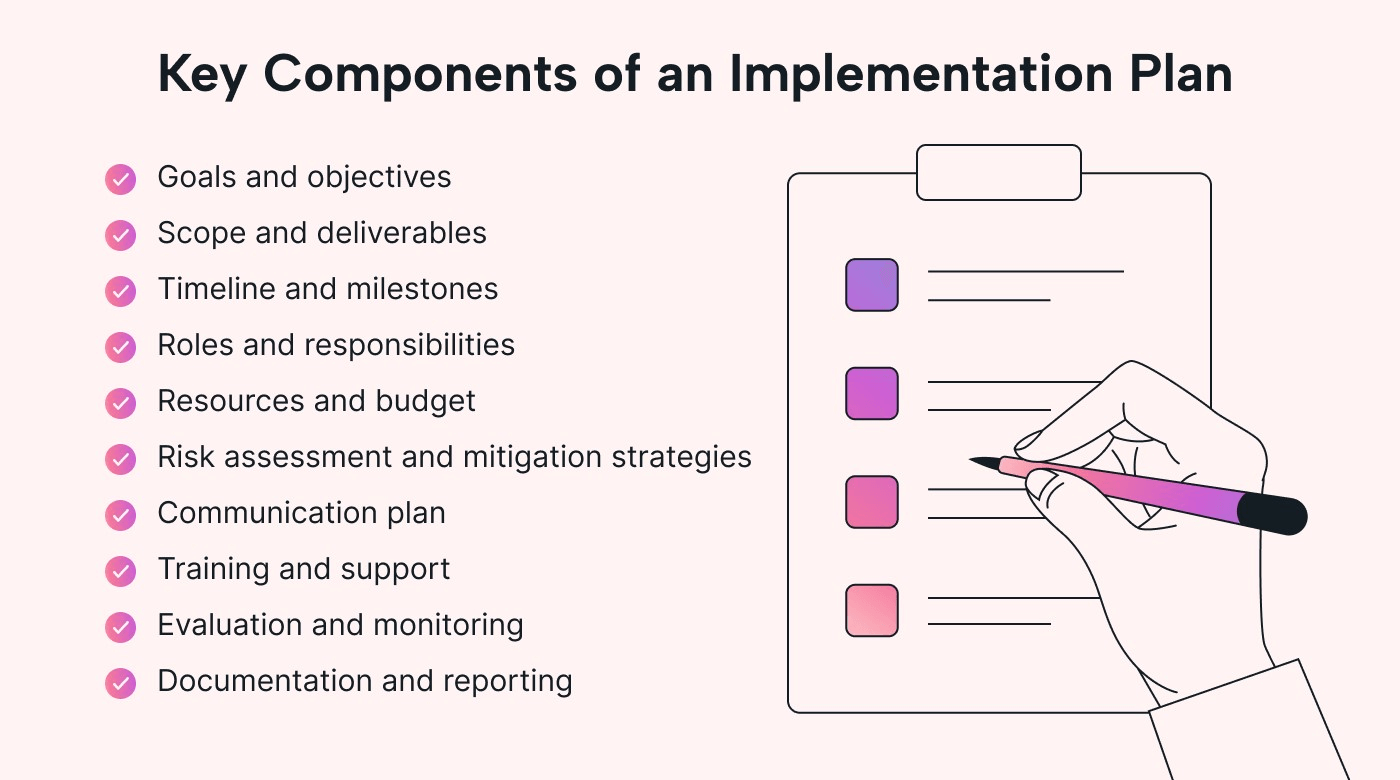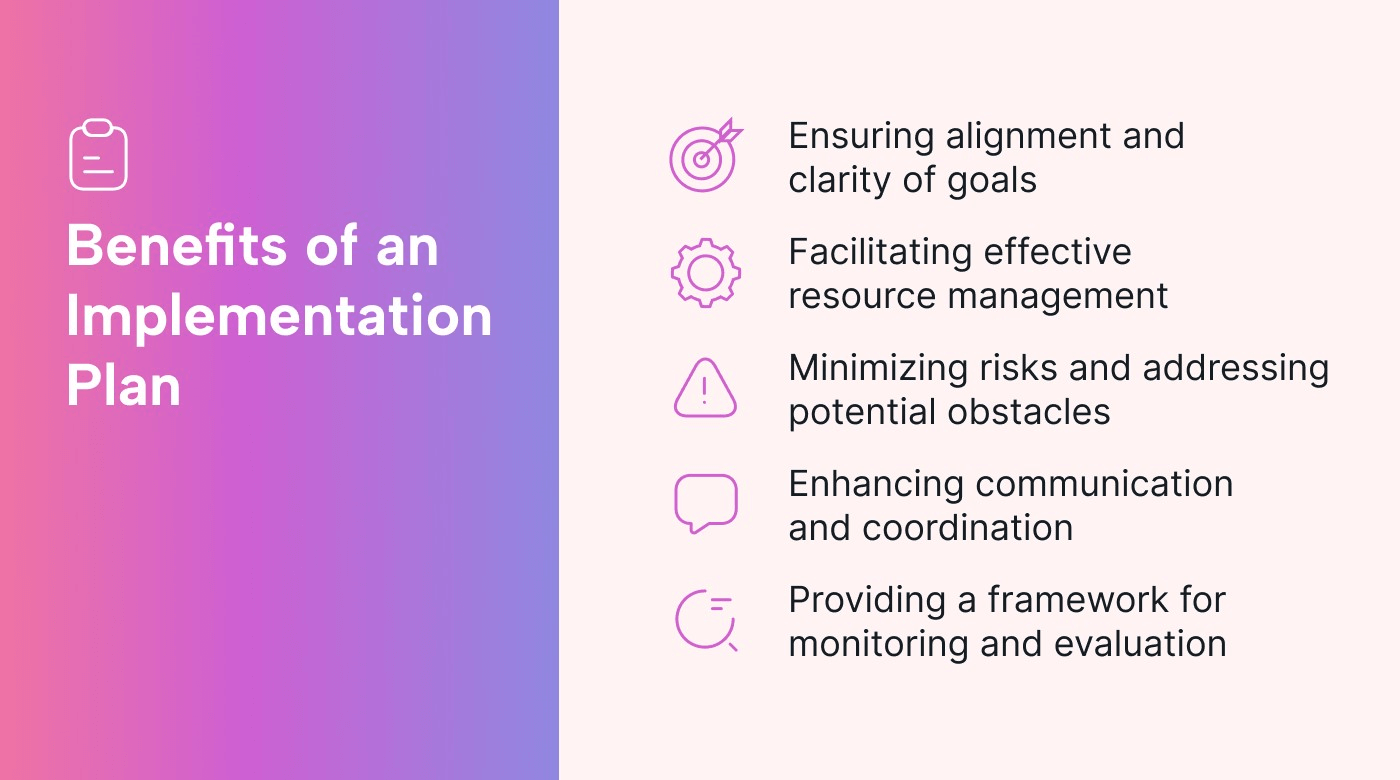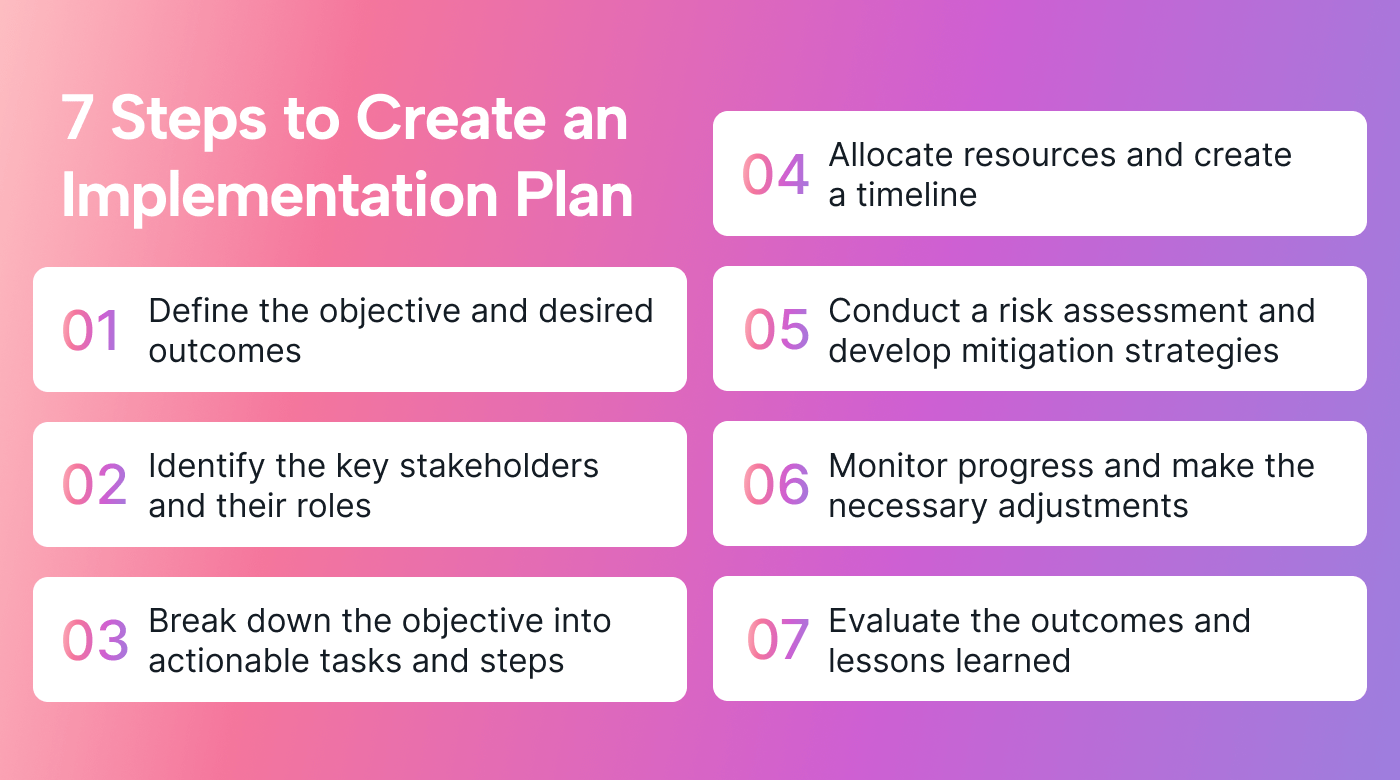As much as we’d love for it to be true, ideas and visions alone are not enough to bring about transformative change. Whether it’s a groundbreaking business strategy or an ambitious personal goal, success hinges on the ability to execute plans effectively.
Implementation plans translate vision into action, turning your aspirations into tangible achievements.
This article covers everything you need to know about implementation plans, from what they should include to how to create one.
What is an implementation plan?
An implementation plan is a strategic roadmap that outlines the steps, resources, and timeline required to bring an idea or vision to fruition. It provides a detailed framework for translating goals and objectives into practical actions.
An effective implementation plan goes beyond simply assigning tasks to team members to include various components that collectively help the team execute the plan.
It typically includes specific activities, milestones, and deadlines to keep everyone on track. It also identifies the resources each task needs, including the required people, tools, and materials.
At the end of the day, an implementation plan allows for better coordination and communication among team members, making sure that everyone is working toward the same goal.
Key components of an implementation plan
An implementation plan is made up of several components that are crucial for a project’s success.
Let’s take a closer look at each of them.
 |
Goals and objectives
Think about the desired outcomes and objectives for the implementation plan. What do you hope to achieve through the project? Your goals should be specific, measurable, attainable, relevant, and time-bound (SMART).
Clearly defined work goals help ensure a shared understanding and direction for everyone involved in the project. Without them, your project will be more likely to fail.
Scope and deliverables
Define the implementation plan’s boundaries and scope. What specific deliverables or milestones need to be accomplished? This helps set clear expectations and establish a timeline.
Timeline and milestones
What are the project’s time restraints? Create a detailed timeline that outlines the implementation process’s major phases, activities, and milestones. This time management strategy allows for better planning and progress tracking.
Roles and responsibilities
Identify the individuals or teams responsible for carrying out different tasks and activities. Clarify each person’s roles, responsibilities, and reporting structures to ensure accountability and coordination.
Resources and budget
At least 85% of every project is over budget to some degree due to unforeseen events. To reduce the likelihood of running out of funds, determine the resources your team needs to successfully execute the plan of action and allocate a budget. Ensure your team has the right technological tools at their disposal.
Risk assessment and mitigation strategies
Identify potential risks and challenges that may arise during implementation. Develop strategies and contingency plans to mitigate those risks and minimize their impact on the project.
Communication plan
Establish a plan for effective communication throughout the implementation process. Define the target audience, key messages, communication channels, and frequency of updates to keep stakeholders informed and engaged.
According to a report on business communication, 72% of business leaders believe that effective communication increases their team’s productivity.
Training and support
Determine the training needs of the individuals involved in the implementation, and develop a plan to provide the necessary training and support. This ensures everyone has the knowledge and skills to carry out their assigned tasks.
According to the World Economic Forum, six in ten workers will require training before 2027, but only half have access to adequate training opportunities today.
Evaluation and monitoring
Define the metrics and evaluation criteria to assess the progress and success of the implementation plan. Regularly monitor and measure the outcomes against the established objectives.
Documentation and reporting
Establish a system for documenting all relevant information, including project plans, progress reports, and any changes made during the implementation. This ensures transparency and provides a record for future reference.
Benefits of creating an implementation plan
Creating an implementation plan can be a difficult process. But when done well, it can bring many benefits for your team and a project’s success. We’ll discuss a few of them below.
 |
Ensuring alignment and clarity of goals
A crucial aspect of any implementation plan is clearly defined outcomes and objectives, which give all stakeholders a shared understanding of what needs to be achieved. This alignment minimizes confusion and keeps everyone focused on the same target.
Facilitating effective resource management
An implementation plan gives teams a comprehensive overview of the required resources, including finances, personnel, and materials. This allows for better planning and allocation, ensuring that the right resources are available at the right times.
Project managers can easily identify potential resource gaps or bottlenecks early and take proactive measures to avoid them.
Minimizing risks and addressing potential obstacles
Implementation plans serve as a helpful tool to predict and handle problems while putting a plan into action.
They provide a structured way to identify and evaluate potential risks and challenges so that steps can be taken in advance to reduce their impact. Managers can monitor progress and make the necessary adjustments to ensure the project stays on track.
Enhancing communication and coordination among team members
A well-thought-out implementation plan becomes a structured framework for sharing information and providing progress updates. Roles, responsibilities, and dependencies are clarified, promoting seamless teamwork. This fosters effective communication, improves collaboration, and helps ensure that everyone is on the same page.
 |
For example, a team member may not know the plan’s next stage, or a project manager may want to follow up on a task’s progress. Instead of sending emails back and forth, they can both refer to the implementation plan as a source of truth.
Providing a framework for monitoring and evaluation
Implementation plans establish clear metrics and evaluation criteria, serving as benchmarks to assess the success of the plan. This systematic approach helps monitor key milestones and outcomes, empowering teams to make data-driven, informed decisions.
For example, say a non-profit organization develops an implementation plan for a community outreach program. The plan includes specific metrics to monitor the program’s success, such as the number of individuals reached, the impact of educational workshops, and participant feedback.
Regularly tracking these metrics and evaluating the program’s effectiveness means the organization can make informed decisions, identify areas for improvement, and demonstrate the program’s value to stakeholders and funders.
7 steps to create an implementation plan
Creating an implementation plan requires seven important steps. Let’s break down each one and use the example of a team developing a mobile app to illustrate the process.
 |
Step 1: Define the objective and desired outcomes
The first step is to clearly define the objective of the mobile app or product launch. For example, the objective could be to develop a user-friendly app that simplifies online shopping, and the desired outcome could be a high user adoption rate and positive customer feedback.
Step 2: Identify the key stakeholders and their roles
Identify the key stakeholders involved in the development and launch process, such as the product team, designers, developers, marketing team, and customer support. Clarify their roles and responsibilities to ensure effective collaboration and smooth project execution.
Step 3: Break down the objective into actionable tasks and steps
Break down the objective into smaller tasks and steps that need to be accomplished. These tasks could include conducting market research, designing a user interface, developing an app, creating marketing materials, and setting up customer support channels.
Step 4: Allocate resources and create a timeline
Allocate the necessary resources, including the budget, personnel, and technology, to support the project’s development and launch. Create a detailed timeline with specific deadlines for each task to help ensure that the development process stays on track.
Step 5: Conduct a risk assessment and develop mitigation strategies
Identify potential risks that may arise during the development and launch phase. These risks could include technical issues, competition, or market changes. Develop strategies to mitigate these risks, such as conducting thorough testing, staying updated on market trends, and establishing backup plans.
Step 6: Monitor progress and make the necessary adjustments
Regularly monitor the progress of the development and launch activities. Keep track of milestones, such as completing design iterations or reaching development checkpoints. If any issues or challenges arise, make necessary adjustments to the plan, such as reallocating resources or adjusting the timeline.
Step 7: Evaluate the outcomes and lessons learned
Once the mobile app or product is launched, evaluate its performance against the defined objectives in your implementation plan. Analyze user feedback, adoption rates, and sales data to measure success. Identify lessons learned from the development and launch process to improve future product releases.
Simplify your implementation plan process with Motion
With proper planning and a clear implementation plan, even the most ambitious ideas can become tangible realities. And the right tools make this process all the more efficient. That’s where Motion’s Project Manager comes in.
Say goodbye to tedious manual tasks and hello to streamlined efficiency with Motion. The app automates time-consuming aspects of your implementation plan, freeing up your team’s energy for what really matters: executing your vision. With Motion, you can easily align your team, track progress, and achieve successful project outcomes.
Simplify your implementation plan and supercharge your team’s productivity with Motion. Sign up for a free 7-day trial today.





